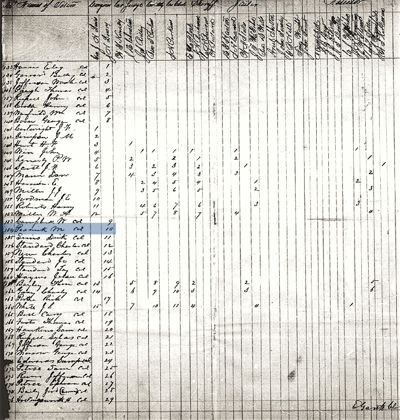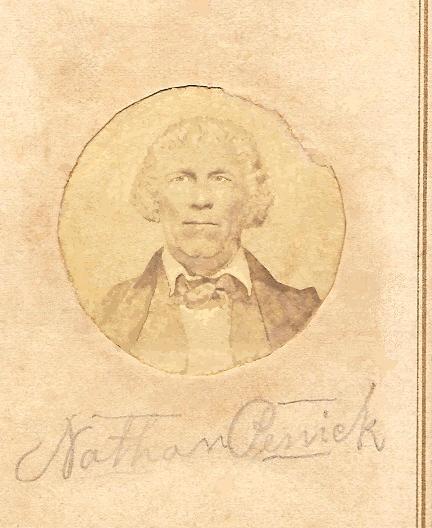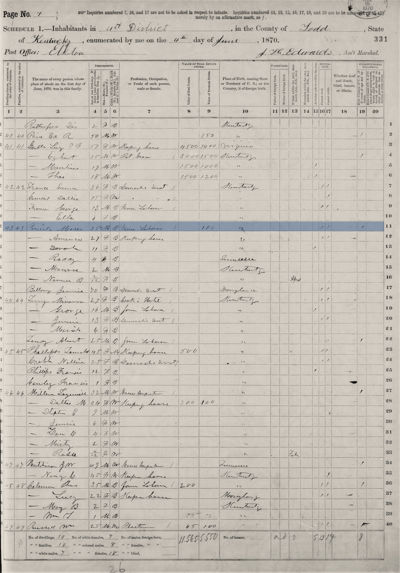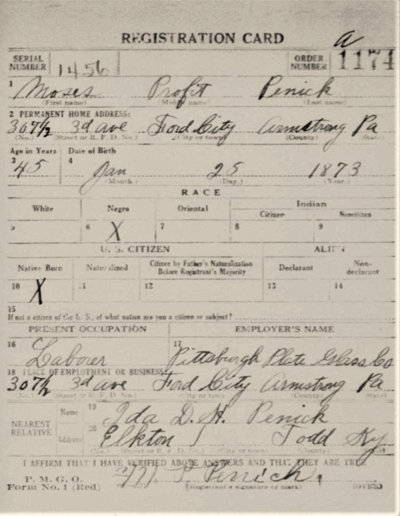

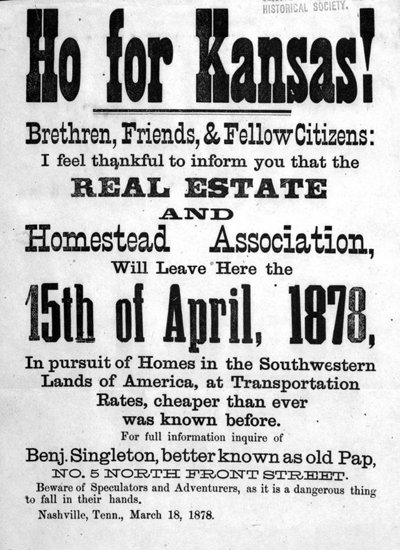
Handbill distributed by Benjamin "Pap" Singleton, a leader of the Exoduster movement, distributed in 1878 in Nashville (just 50 miles south of Elkton), encouraging African Americans to emigrate to Kansas. Similar handbills were likely distributed to African Americans in Todd County.
1878, Kansas Historical Society.
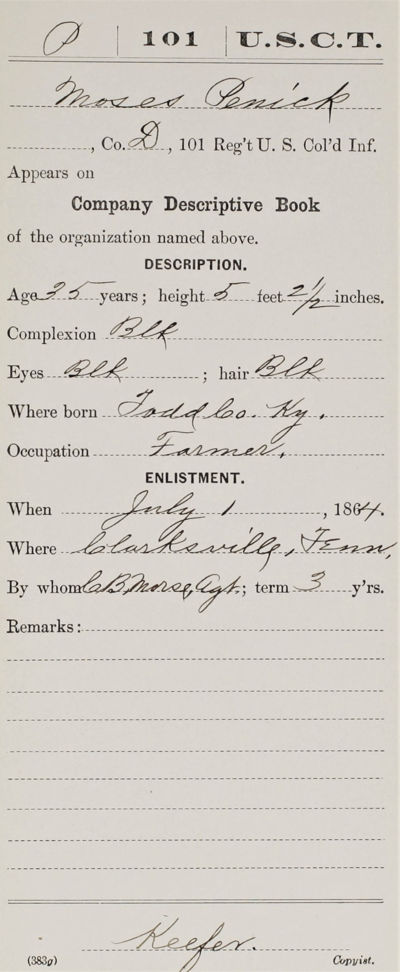
Moses Penick’s enlistments papers (from the company descriptive book). Typically, the company descriptive book notes the “reputed owner” of the enlister in the “Remarks” section. Note that the “Remarks” section on Moses’ papers is blank.
National Archives, Civil War Service Records, Colored Troops.
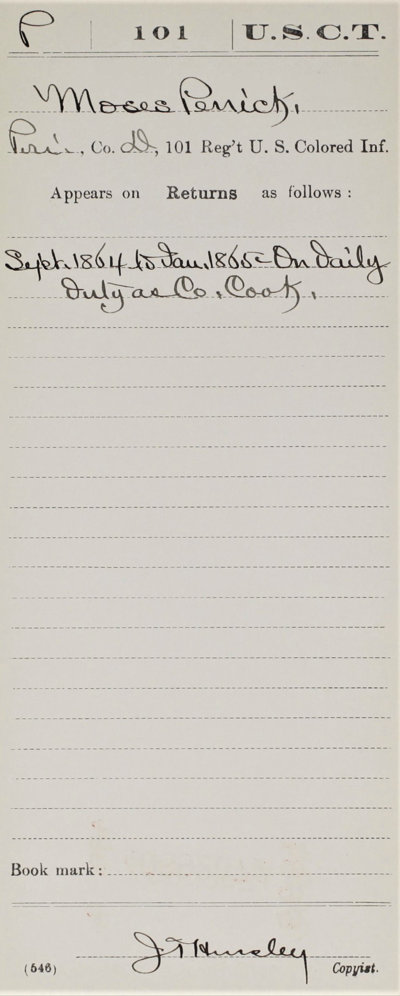
A page from Moses Penick’s military records, showing that between September 1864 to January 1865 he was on daily duty as Company D’s cook.
National Archives, Civil War Service Records, Colored Troops.

Illustration of a common type of cooking used by cooks in the Union Army (kettles over a campfire) from James M. Anderson, 1862, “Culinary Hints for the Soldier” (published by the U.S. Government).
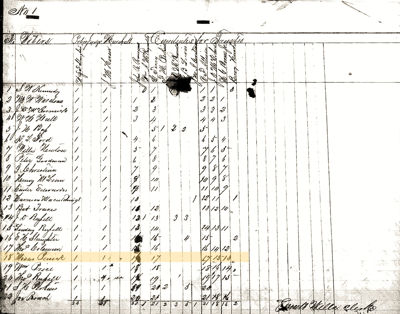
The first page of the June 6, 1870, pollbook for the local town election in Elkton showing Moses Penick, the 18th voter of the day, and his vote for police judge, town marshal, and town trustee (highlighted in yellow).
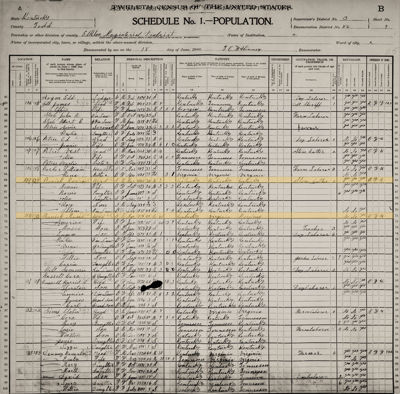
A page from the 1900 U.S. Census for Todd County, showing the families of Monroe and Moses Penick living next door to each other.
Moses Penick
The Penick Family Decides Whether to Stay or Leave Todd County
About a quarter of the way through the day, in the first election in which black men could vote, Moses Penick stepped forward to declare his choices. It was Tuesday, April 25, 1870, and Moses was the 154th voter of the day at Elkton courthouse. He voted among friends and neighbors and would be a regular political participant, voting in all the elections for which we have uncovered surviving Elkton precinct pollbooks.
A veteran, homeowner, Republican, and member of the emergent black middle class, Penick chose to stay in Todd County. He and his wife, America, lived in the Elkton area until their deaths. Later, after the dust had settled on the uncertainty, chaos, and opportunity of the War and Reconstruction, options for black advancement in Todd County narrowed. Moses’ children and grandchildren faced a choice: stay in the Todd County and weather discrimination or pursue economic opportunities in the North?
Moses’ and America’s family, like other families, was split over whether to go or stay. Some members stayed. Others became part of the mass outmigration of African Americans from the South to the North and West after the Civil War that saw tens of thousands of African Americans move to Kansas (the "Exodusters”), gave western states like California their first sizable black populations, and brought African Americans to the big industrial cities of the North. This outmigration peaked after World War I, when the “Great Migration” began. Over the next half a century (1916-1970), over six million African Americans left the South.
The story of the Penick family provides a case study of the decisions that faced a new generation of men who came of age after the Civil War: stay in the South with limited opportunities or seek a future far from the legacy of slavery where opportunities were greater. In Todd County, the choice was especially stark for anyone without a specialized trade or skill: a life of dead-end jobs in the tobacco industry (with its brutal culture and risk of nicotine poisoning) versus high paying industrial jobs in the North.
Black immigration out of Kentucky began in earnest after the War. Todd County’s black population, which reached its peak of 4,895 in 1850, had begun its absolute and relative decline by 1870 and would continue to decline for decades as men sought opportunities elsewhere.
Growing up Property
Likely born around 1830, Moses Penick spent the first three decades of his life as property. In 1860, he was owned by Nathan Penick, a Virginia native who settled in Todd County in 1847. Moses lived at the Penick tobacco farm five miles southeast of Elkton on the Allensville Road, in the heart of Todd County’s highly profitable tobacco plantation country. Nathan and his wife Nancy produced 13 children on an equally vast property of 600 acres that produced 38,000 pounds of tobacco a year on the labor of 30 black men, women and children, one of the largest enslaved populations in the county.
As with many enslaved people, Moses did not know his birthdate, and estimates of his age vary wildly in official records. Moses died on October 15, 1912, and his death certificate states he was 86, born in Todd County in 1826. His father (Peter Bellamy) and mother were Virginians.
Like others enslaved by the family, including Aaron and Jake, Moses Penick would have spent his days doing back-breaking labor weeding, pruning, removing worms and caterpillars, harvesting, drying, curing over fire, and stripping black leaf tobacco.
A Cook in the U.S. Colored Troops
On July 1, 1864, only a few months after his enslaver Nathan died, Moses made his way to Clarksville, Tennessee, about 25 miles southwest of the Penick plantation, to enlist in the Union Army. It is likely that Nathan’s estate had not yet been legally administered, meaning Moses, now in his 30s, did not technically have an owner. This appears to be reflected in Moses’ enlistment papers which, unlike many U.S. Colored Troops enlistment papers, do not note the name of his “reputed owner.”
Moses served in the 101st Colored Infantry, Company D, as the company cook, using campfires and kettles to make the company’s meal when it was not mobile as part of a campaign. He served until January 1866 and was mustered out in Nashville on January 21. When he mustered out the U.S. military owed him $40.76.
Settling and Voting in Elkton
By 1870, Moses was back in Todd County, living a few miles from the Penick Farm and just outside of the town limits of Elkton. He lived with his wife, America, and four children — Sarah, 11; Roda, 4; Monroe, 2; and Nannie B., 2 months. The family rented a place on the outskirts of Dunheath Estate, the oldest house in Elkton (built in 1810).
Also living with Moses and America in 1870 was 70-year-old Jennie Bellamy, who is likely to have been Moses’ mother or relative. Moses was working on a farm and had grown his personal estate to $100.
Among Moses’ neighbors included some very powerful Democrats: Dunheath was owned by Lucy Garth and her son Egbert (the 1870 election clerk who recorded Moses’ first ever vote), James D. Christian, the most powerful official in the county, and Benjamin Thomas Perkins, Clerk of the Todd County Court and the Circuit Court.
Penick was an avid voter. In 1870, he made the trek into town to vote at the Elkton Courthouse at least three times: In April, June, and November. In June, he voted for town trustees, Elkton’s town government, in a hyper local election with only 103 voters in total.
Penick’s close proximity to powerful Democrats did not dampen his enthusiasm for Republican candidates at the national level. In both the April and November congressional elections, he voted for Republican candidates.
Indeed, even at the local level, Moses voted for turned out to vote and voted Republican. In the August 1872 election for county officials, Moses declared his vote for Cole, the Republican candidate. He did vote for William T. Kennedy, a lawyer from a deeply Democratic family whose uncle was a delegate to the 1861 Russellville confederate convention that set up a shadow confederate government in Kentucky. However Kennedy ran uncontested, and all but nine black voters at Elkton that day declared his vote for him.
When the census collector came around in 1880, Moses and America still lived in the same area, on the edge of Elkton. They had three more children: Moses Jr, 7; Ida, 5; and Eugene, 4. Moses was working as a laborer.
Moses and America were longtime residents of Todd County. They stayed in Elkton in the home they owned, living with various adult children, and next door to their eldest son, Monroe, a homeowner and stonemason. It appears Moses owned multiple properties: he sold a small parcel of land located east of Elkton to Monroe in 1908.
Moses applied for a disability pension in 1890 but continued to work into old age, laboring as a gardener in 1910, aged about 80. America died after 1900. Moses followed in 1912, with his Todd County death certificate recording his age as 86 and his cause of death as complications of malaria and old age.
Should I Stay or Should I Go?
For Moses and America’s children and grandchildren, the choice to stay in Todd County was less clear. Economic opportunities in the industrial north encouraged some of his family to move far away, while others stayed in their hometown. Moses’ eldest son Monroe, remained in Elkton until his death in 1955; his second eldest son, Moses Jr. headed north to a glass factory and a stable wage.
Monroe Stays in Elkton
Monroe remained in Todd County, living on that property to the east of Elkton that he bought from his father. He worked as a farmer and a stone cutter over the decades, as recorded in the 1910, 1930, and 1940 censuses. His wife, Minnie, bore three children: 2 daughters and a son.
Monroe and Minnie’s youngest daughter, Lola, born around 1898, chose to follow her father’s path. She stayed in Todd County. She worked as a teacher in a local public school and still lived with her parents, single, in 1940. By contrast, their son, Roy, moved northward, working in the auto industry of Detroit in 1930 (aged 30) and as a pin getter in a bowling alley in Pittsburgh in 1940 (aged 39). A single man, he lived in black households with other southern migrants from Alabama, Missouri, Mississippi, North Carolina, and South Carolina.
Moses Jr. Seeks Opportunities in the North
After seemingly settling in Todd County — getting married and buying property in Elkton — Moses’ second eldest son, Moses Jr. joined the Great Migration during World War I.
According to the 1910 Census, Moses Jr, had bought a house near his parents in the town of Elkton, and lived with his wife Ida. He was a local schoolteacher.
However, only a few years later, he headed northward for work. He moved to Pennsylvania to work at Pittsburgh Plate Glass Company (PPGC) during World War I. His draft registration card shows he was living in Ford City, while Ida remained behind in Elkton, in 1917.
Ford City, Pennsylvania, founded in 1887, was a company town and the site of PPGC’s Works No. 3 glass factory, the largest glass plate factory in the world. As many as 5,000 workers were employed in the factory in the 1910s, many of them eastern and southern European immigrants and others black Southerners who had made the same calculation as Moses Jr.
We know from a Kentucky Court of Appeals case that Moses Jr. remained in Ford City working at the factory until his death in 1921, while Ida remained back in Elkton.
Stories like that of the Penicks are typical of the time. Racial and class hierarchies soon hardened after being smashed by the Civil War, meaning fewer opportunities for young black people and hard choices about leaving family and familiarity in the South.


